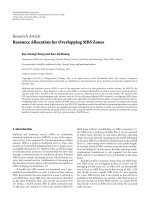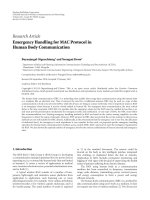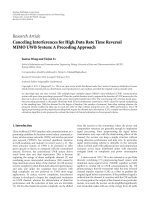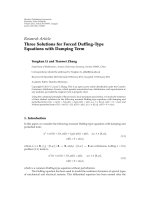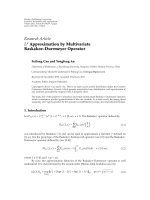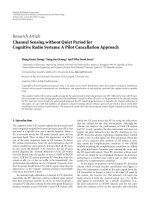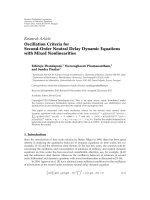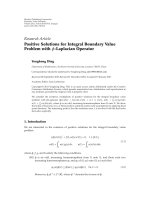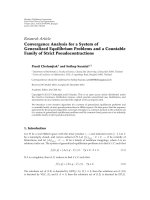Báo cáo hóa học: " Research Article Channel Estimation for Two-Way Relay OFDM Networks" pot
Bạn đang xem bản rút gọn của tài liệu. Xem và tải ngay bản đầy đủ của tài liệu tại đây (584.86 KB, 6 trang )
Hindawi Publishing Corporation
EURASIP Journal on Wireless Communications and Networking
Volume 2010, Article ID 186182, 6 pages
doi:10.1155/2010/186182
Research Article
Channel Estimation for Two-Way Relay OFDM Networks
Weiwei Ya ng,
1, 2
Yueming Cai,
1, 2
Junquan Hu,
1
and Wendong Yang
1
1
Institute of Communications Engineering, PLA University of Science and Technolog y, Nanjing 210007, China
2
National Mobile Communications Research Laboratory, Southeast University, Nanjing 210096, China
Correspondence should be addressed to Weiwei Yang, yww
Received 31 December 2009; Revised 18 May 2010; Accepted 8 July 2010
Academic Editor: Xiaodai Dong
Copyright © 2010 Weiwei Yang et al. This is an open access article distributed under the Creative Commons Attribution License,
which permits unrestricted use, distribution, and reproduction in any medium, provided the original work is properly cited.
We consider the channel estimation for two-way relay OFDM networks. We proposed an LS-based channel estimation algorithm
under block-based training schemes. Based on the mean square error (MSE) criterion, the condition and the design method for
optimal training sequences are discussed. To reduce peak-to-average power ratio (PAPR), a special sequence called Zadoff-Chu
sequence is employed to design the optimal training sequence, which can achieve both minimum MSE performance and excellent
PAPR performance.
1. Introduction
Two-way communication is a popular type of modern com-
munications, where two source terminals simultaneously
communicate. The two-way channel was first considered
by Shannon, who derived inner and outer bounds on the
capacity region [1]. Recently, the two-way relay networks
(TWRNs) have attracted a great deal of research interest [2–
13], due to its potential application in cellular networks and
peer-to-peer networks. Both amplify-and-forward (AF) and
decode-and-forward (DF) protocols developed for one-way
relay channels are extended to the half-duplex additive white
Gaussian noise (AWGN) two-way relay channel (TWRC)
in [2] and the general full-duplex discrete TWRC in [3].
Furthermore, physical layer network coding is considered in
[5, 6] for AWGN TWRC. Cui et al. have studied a differential
network coding at the physical layer in [7]. The optimized
relaying strategies for TWRC have been proposed in [8].
Information-theoretic results on TWRN were also presented
in [12, 13].
However, many studies have focused on narrowband
systems and flat fading environments. Since broadband
transmission, such as orthogonal frequency division multi-
plexing (OFDM) or single carrier cyclic prefix (SCCP), is
likely to be a key element in future wireless communication
systems, two-way relay techniques should be investigated
for such systems. Compared to the narrowband case, the
problem at hand is different due to the increase in degrees
of freedom brought by OFDM or SCCP. In [14], two-way
relaying over parallel tones of OFDM systems is investigated.
The throughput of TWRN is discussed for high-speed
802.11n WLANs in [15]. The-Hanh Pham extended two-
way relay communication to the frequency selective fading
environment where SCCP was employed in [16].
All the existing work has assumed perfect channel state
information (CSI) at both the relay node and/or the two
terminals. However, under the assumption of coherent
detection, the fading channel coefficients need to be first
estimated and then used in the detection process. The quality
of channel estimates inevitably affects the overall perfor-
mance of relay-assisted transmission and might become a
performance limiting factor [17]. Although there have been
some discussions on the channel estimation for one-way
relay networks [18–20], little work has been done for the
TWRN. Recently, Gao et al. have studied the maximum
likelihood (ML) and the linear maximum SNR (LMSNR)
channel estimation for two-way AF relay networks over the
flat fading channels in [21], and pointed out that there exist
many challenges since the channel estimation is required
not only for data detection but also for self-cancelation at
the two terminals. The optimal training sequence has been
designed to minimize the mean square error of the channel
estimation for two-way SCCP systems according to zero-
forcing criterion over frequency selective fading channels
2 EURASIP Journal on Wireless Communications and Networking
in [16]. Two different typ es of training based on pilot-
tone and block, respectively, were proposed to develop their
corresponding channel estimation algorithms for OFDM
modulated TWRN in [22].
In this work, we consider the channel estimation for two-
way relay OFDM networks. Due to the nature of the signal-
ing, we estimate two composite channels instead of separately
estimating the two links from the source nodes to the relay
node. Based on the mean square error (MSE) criterion, a
design method for training sequences is proposed. Different
from [22], to reduce peak-to-average power ratio (PAPR), a
special sequence called Zadoff-Chu sequence is employed to
design the optimal training sequence for TWRN, which can
achieve the same minimum MSE performance as the training
sequences in [22] with better PAPR performance.
This paper is organized as follows. Section 2 introduces
the two-way relay OFDM system. Least-square channel esti-
mation is developed in Section 3, and the optimal training
sequence to reduce PAPR is also designed in this section.
Section 4 discusses the numerical results. Finally, Section 5
concludes the paper.
Notations. The capital bold letters denote matrices and the
small bold letters denote row/column vectors. Transpose,
Hermitian transpose of a vector/matrix are denoted by (
·)
T
and (·)
H
, respectively. The identity matrix of size N is
denoted by I
N
.0
m,n
stands for a zero matrix of size m × n.
For a matrix B,[B]
m,n
is the (m, n)th element of B. diag(b)is
a diagonal matrix whose diagonal entries are from vector b.
The Hadamard product and convolution of two vectors a and
b are denoted as a
b and a ⊗ b,respectively.E{·} denotes
expectation operation.
2. Two-Way Relay OFDM Model
Consider a two-way relay network where the two source
nodes, Tx1 and Tx2, exchange information relying on the
help of a relay node R. The relay node and the two source
nodes are assumed to equip single antenna each. Here, we
employ the two-way relay protocol the same way as proposed
in [10]. The bidirectional communication is performed slot-
wise, while one t ime-slot is divided into two phases of equal
duration, namely, the multiple access (MAC) and broadcast
(BC) phase. During the MAC phase, both source nodes,
Tx1 and Tx2, send one signal frame to the relay node R
whereas during the BC phase, R processes the received signals
and broadcasts them to Tx1 and Tx2. We assume perfect
synchronization for both tr ansmission phases.
For a given time-slot, the fading channels between Tx1
and Tx2 to R are assumed to be quasistatic frequency selec-
tive fading, that is, they do not change within one time-slot
of transmission but can vary from one time-slot to another
independently. Let h
1
= [h
1
(0), , h
1
(L)]
T
and h
2
=
[h
2
(0), , h
2
(L)]
T
be the discrete-time baseband equivalent
impulse response vectors of the frequency selective fading
channels between Tx1 and Tx2 to R, respectively, where
L represents the number of the taps of the corresponding
channel. The channel impulse response includes the effects of
transmit receive filters, physical multipath, and relative delays
among antennas. Each element of h
1
or h
2
is modeled as a
zero-mean complex Gaussian random variable with variance
σ
2
i,l
, i = 1, 2, l = 0, , L. These elements are also assumed to
be independent of one another. The time-division duplexing
(TDD) is a generally adopted assumption for TWRN, where
the channels can be considered reciprocal so that the channel
from R to Tx1 is still h
1
and the channel from R to Tx2 is
still h
2
. The frequency-domain channel coefficient matrix is
H
i
= diag{H
i
(0), , H
i
(N − 1)}, i = 1, 2 where H
i
(n) =
L
l
=0
h
i
(l)e
−j2πnl/N
is the channel frequency response on the
nth subcarrier and N is the number of subcarriers.
For a given t ime-slot, the signal frame contains multiple
OFDM blocks, while each OFDM block contains informa-
tion symbols and a cyclic prefix (CP) of length L
CP
.The
length of the CP, L
CP
, is greater than or equal to the channel
memory to avoid the interblock interference (IBI), L
CP
≥ L.
At the MAC phase, the input data bits are first mapped
to complex symbols drawn from a signal constellation such
as phase shift keying (PSK) or quadrature amplitude modu-
lation (QAM). We use s
k
1
= [s
k
1
(0), , s
k
1
(N − 1)]
T
and s
k
2
=
[s
k
2
(0), , s
k
2
(N − 1)]
T
to denote the kth frequency-domain
symbol vectors transmitted from Tx1 and Tx2, respectively.
The cyclic prefix (CP) is added to the top of each signal vector
after taking IFFT, respectively. The power constraints of the
transmission is E
{s
kH
1
s
k
1
}=E{s
kH
2
s
k
2
}=P,whereP is the
average transmitting power of Tx1 and Tx2 without loss of
generality.
These signal frames are transmitted simultaneously from
Tx1 and Tx2 to R. At R, the received signals associated
with the CP portion are discarded first. Then the remaining
received signals are scaled by a real factor α to keep the
average power of R to be P
r
. The resultant signals are CP-
added and broadcasted to Tx1 and Tx2 during the second
phase.
The kth received signal vector at R after the MAC phase
is
r
k
1
=
H
1
F
H
s
k
1
+
H
2
F
H
s
k
1
+ w
k
1
,(1)
where
H
1
and
H
2
are two N × N circulant matrices with
[h
T
1
, 0
1×(N−L−1)
]
T
and [h
T
2
, 0
1×(N−L−1)
]
T
as their first columns,
respectively; F is the unitary discrete Fourier transform
matrix with [F]
m,n
= (1/
√
N)e
−j2πmn/N
; w
k
1
is an additive
white Gaussian noise (AWGN) vector with zero mean and
covariance matrix E
{w
kH
1
w
k
1
}=σ
2
w
I
N
. The received signal
vector in (1) is then amplified by a real coefficient which is
given by
α
=
P
r
L
l
=0
σ
2
1,l
+
L
l
=0
σ
2
2,l
P + σ
2
w
. (2)
The last L
CP
components of the vector are appended
to the top of itself and the resultant vector is broadcasted
to both Tx1 and Tx2. Without loss of generality, we only
consider the channel estimation problem at Tx1. A similar
operation can be applied at Tx2.
EURASIP Journal on Wireless Communications and Networking 3
The kth received signal vector at Tx1 after removing CP
and taking FFT can be written as follows:
r
k
2
= αF
H
1
r
k
1
+ F w
k
2
= αF
H
1
H
1
F
H
s
k
1
+ αF
H
1
H
2
F
H
s
k
1
+ w
k
2
,
(3)
where w
k
2
= αF
H
1
w
k
1
+ F w
k
2
, w
k
2
is an AWGN vector with
zero mean and covariance matrix E
{w
kH
2
w
k
2
}=σ
2
w
I
N
.Based
on the DFT theory, with a condition of (2L +1)
≤ N,let
h
= h
1
⊗ h
1
= [h(0), h(1), , h(2L)]
T
and g = h
1
⊗ h
2
=
[g(0), g(1), , g(2L)]
T
, we obtain that
r
k
2
= α diag
s
k
1
F
L
h + α diag
s
k
2
F
L
g + w
k
2
,(4)
where F
L
is the first 2L +1columnsofF,andw
2
is a AWGN
vector with zero mean and covariance matrix E
{w
kH
2
w
k
2
}=
σ
2
w
(α
2
(
L
l=0
σ
2
1,l
)+1)I
N
.
Equation (4) can be written in another form as
r
k
2
=
α diag
s
k
1
F
L
α diag
s
k
2
F
L
h
g
+ w
k
2
= S
k
θ + w
2
,
(5)
where S
k
= α[diag(s
k
1
)F
L
diag(s
k
2
)F
L
]andθ = [h
T
g
T
]
T
.
In this paper, we use all the carriers in one or more
OFDM blocks for channel estimation normally happening at
the start of the transmission, where these OFDM blocks are
known as the training sequence. In the next section, without
loss of generality, we use one OFDM block as training to
estimate θ
= [h
T
g
T
]
T
. For the notational convenience, we
omit the time index k in the following.
3. Least-Square Channel Estimation and
Optimal Training Sequence Design
From (5), the least-square estimation of the composite
channel θ is given by
θ
S
H
S
−1
S
H
r
2
= θ +
S
H
S
−1
S
H
w
2
. (6)
The MSE of the estimation is defined as
MSE
1
2
(
2L +1
)
E
θ − θ
H
θ − θ
. (7)
Substituting (6)to(7), we can obtain that
MSE
=
1
2
(
2L+1
)
tr
S
H
S
−1
S
H
E
w
H
2
w
2
S
H
S
−1
S
H
H
=
σ
2
w
α
2
L
l
=0
σ
2
1,l
+1
2
(
2L +1
)
tr
S
H
S
−1
.
(8)
It is clear from (8) that minimizing MSE is equivalent to
minimizing Q tr
{(S
H
S)
−1
}. From the above, we design the
training sequences s
1
and s
2
so that Q is minimized.
Let A
= (S
H
S)
−1
, using (5), we can obtain that
A
=
1
α
2
⎛
⎜
⎝
F
H
L
diag
s
H
1
s
1
F
L
F
H
L
diag
s
H
1
s
2
F
L
F
H
L
diag
s
H
2
s
1
F
L
F
H
L
diag
s
H
2
s
2
F
L
⎞
⎟
⎠
−1
B
.
(9)
For a 2(2L +1)
×2(2L + 1) positive definite matrix A,we
have
Q
= tr{A}≥
1
α
2
2
(
2L+1
)
i=1
[
B
]
i,i
, (10)
where the equality holds if and only if A is diagonal. Applying
the Cauchy-Schwartz inequality on the RHS of (10), we
further obtain
Q
≥
1
α
2
(
2
(
2L +1
))
2
(
2L+1
)
2
(
2L+1
)
i=1
[
B
]
i,i
(11)
where equality holds if and only if [B]
i,i
’s are equal.
From (11), we get that to achieve minimum MSE, the
training signal vectors s
1
and s
2
must be designed to meet
the following conditions:
(1) F
H
L
diag(s
H
2
s
1
)F
L
= F
H
L
diag(s
H
1
s
2
)F
L
= 0
2L+1
;
(2) F
H
L
diag(s
H
1
s
1
)F
L
and F
H
L
diag(s
H
2
s
2
)F
L
are two diagonal matrices with equal diagonal elements.
Based on conditions (1) and (2), we can achieve the
minimum MSE:
MSE
min
=
σ
2
w
α
2
L
l
=0
σ
2
1,l
+1
α
2
[
B
]
p,p
,
(12)
where the arbitrary p belongs to the interval
{1, ,2(2L +
1)
}.
To meet conditions (1) and (2), we can design different
kinds of the training s
1
ands
2
. For instance, we can orthogo-
nally design s
1
and s
2
according to [22]
s
1
(
i
)
= 1, s
2
(
i
)
= e
j2πiw/N
, i = 0, , N −1, (13)
where w
∈{2L+1, , N −2L−1}. Obviously, the training s
1
and s
2
according to (13) can meet conditions (1) and (2), and
achieve the minimum MSE in (12). However, the training
s
1
and s
2
according to (13) may have high peak-to-average
power ratio (PAPR), PAPR
= max
n=0, ,N−1
[s
i
(n)]/E[s
i
(n)] =
N. The high PAPR brings signal distortion in the nonlinear
region of high-power amplifier (HPA), and the signal distor-
tion induces the degradation of the detection performance.
Here, the high PAPR of the training sequence will result in
channel estimation errors.
To reduce PAPR of the training sequence, the time-
domain signals should have constant magnitude. In [23], a
special sequence, called Zadoff-Chu sequence, was proposed.
All elements of this sequence have the same magnitude in
both time and frequency domain. In this paper, we can
4 EURASIP Journal on Wireless Communications and Networking
design the optimal t raining sequence based on the Zadoff-
Chu sequence. The general form of a Zadoff-Chu sequence
of length M is given as follows:
m
(
n
)
=
⎧
⎨
⎩
e
−jπUn(n+2d)/M
, n = 0, , M − 1; M is even,
e
−jπUn(n+1+2d)/M
, n = 0, , M − 1; M is odd,
(14)
where d is an integer and U is an integer relatively prime to
M.
Based on a Zadoff-Chu sequence m
= [m(0), , m(N/2
− 1)]
T
of length N/2, we repeat m twice to construct s
1
=
[m
T
, m
T
]
T
, and then element-wise multiply s
1
with e
1
to
construct
s
2
= s
1
e
1
,where e
1
= [1, e
j2π/N
, , e
j2π(N−1)/N
]
T
.
So, the frequency transform s
i
= [s
i
(0), , s
i
(N − 1)]
T
of
s
i
, i = 1, 2, can be determined by
s
i
(
k
)
=
⎧
⎨
⎩
√
2m
((
k
− i
)
/2
)
, k = I
i
,
0, else,
(15)
where I
i
={i − 1, i +1, , i + N − 3},andm
(k) =
N/2−1
n=0
m(n)e
−j2πnk/N
is the frequency transform of m.
Based on (15), and I
1
∩ I
2
=∅, we can obtain that
diag(s
H
2
s
1
) = 0, therefore condition (1) can be met.
And
Π
i
= F
H
L
diag
s
H
i
s
i
F
L
= F
H
L
diag
|
s
i
(
0
)
|
2
, , |s
i
(
N
− 1
)
|
2
T
F
L
,
(16)
where
|s
i
(k)|
2
= 2|m
((k − i)/2)|
2
= 2ifk ∈ I
i
and |s
i
(k)|
2
=
0ifk
/
∈I
i
.
So, (Π
i
)
p,q
for p, q = 0, 1, ,2L is determined as follows:
(
Π
i
)
p,q
=
k∈I
i
|s
i
(
k
)
|
2
e
j2πkp/N
e
−j2πkq/N
= 2N
k∈I
i
e
j2πk(p−q)/N
=
⎧
⎪
⎪
⎪
⎨
⎪
⎪
⎪
⎩
N,ifq = q
2Ne
j2πi(p−q)/N
1 − e
j2π(p−q)
1 − e
j4π(p−q)/N
. if q
/
=q
(17)
Considering 0
≤|p − q|≤2L, in order not to make the
quantity 1
− e
j4π(p−q)/N
equalto0,wehavetorestrictL as
follows:
2L<
N
2
⇐⇒ L<
N
4
. (18)
With the condition of (18), we have
(
Π
i
)
p,q
=
⎧
⎨
⎩
N,ifp = q,
0, if p
/
=q
.
(19)
It is easy to see that A in (10) is a diagonal matrix with
equal diagonal elements of 1/α
2
N.
So, based on the Zadoff-Chu sequence, we can design the
training sequences s
1
and s
2
to achieve minimum MSE:
MSE
min
=
σ
2
w
α
2
L
l=0
σ
2
1,l
+1
α
2
N
. (20)
On the basis of the previous assumption, the MSE
performance of the training sequences s
1
and s
2
according
to (20 ) is in direct proportion to the noise power σ
2
w
and in inverse proportion to the number of subcarriers N.
Because of one OFDM block as training to estimate the
channels, larger N implies more transmitted power being
employed by channel estimation, which can achieve better
MSE performance.
Because of the property of the Zadoff-Chu sequence
according to (14), the designed training sequences s
1
and s
2
can also achieve the minimum PAPR performance with
PAPR
= 1, in which the power of the time domain
signal
s
1
and s
2
of s
1
and s
2
keep constant, respectively.
So, the proposed optimal training sequences can achieve
the same minimum MSE performance as the orthogonal
optimal tra ining sequences according to (13)withbetter
PAPR performance. Furthermore, from (18), we can obtain
that the maximum channel length supported by the LS-based
estimation method is N/4+1.
4. Simulation Results and Discussion
In this section, we present computer simulations to verify
our theoretical analyses. We assumes L
= 4, L
CP
= 8, and
N
= 64. We further assume that the power delay profile
of each channel is uniform, that is, each tap of h
1
or h
2
is modeled as a zero-mean Gaussian random variable with
variance E
{|h
i
(l)|
2
}=1/(L +1),i = 1, 2 and l = 0, 1, , L.
The channels are assumed to be static over 50 time slots. The
first time slot is used to estimate the channel information
and the remaining are used for data transmission. For data
transmission, BPSK modulation is deployed.
The four different trainings are considered, including
the random training sequences whose elements are ran-
domly chosen form BPSK signaling, the orthogonal training
sequences which are distinct columns of Hadamard matrix
of size N, the orthogonal optimal training sequences a ccord-
ing to (13), and the Zadoff-Chu-based optimal training
sequences. We compare both MSE performance as well as
symbol error rate (SER) performance for two-way relay
OFDM networks.
Figure 1 shows the MSE performance between
θ and
θ for different training sequences. Figure 2 shows the SER
performance for different training sequences. The four kinds
of training sequences have the same power. The MSE per-
formances obtained using random sequences or orthogonal
EURASIP Journal on Wireless Communications and Networking 5
0 5 10 15 20 25 30
10
0
10
−1
10
−2
10
−3
10
−4
10
−5
SNR (dB)
MSE
Randon training
Orthogonal training
Orthogonal optimal training
Zadoff-Chu optimal training
Figure 1: MSE performance for different SNR.
0 5 10 15 20 25 30
10
0
10
−1
10
−2
10
−3
SNR (dB)
SER
Exact channel
Randon training
Orthogonal training
Orthogonal optimal training
Zadoff-Chu optimal training
14.5 15 15.5
10
−1.3
10
−1.2
Figure 2: SER performance for different SNR.
sequences are worse compared with those of our proposed
optimal design. From Figure 1, it is observed that both the
orthogonal optimal training sequences and the Zadoff-Chu-
based optimal training sequences can achieve the same and
minimum MSE performance. From Figure 2,itisobserved
that the SER performance of the Zadoff-Chu-based optimal
training sequences is same as that of the orthogonal optimal
training sequences and much better that of the random
training sequences and the orthogonal training sequences.
However, the Zadoff-Chu-based optimal training sequences
can also achieve better PAPR performance with PAPR
= 1
than the orthogonal optimal training sequences according to
[22], obviously.
5. Conclusion
In this paper, we proposed LS-based channel estimation
algorithms under block-based training schemes for two-way
relay OFDM networks. By minimizing MSE, the condition
and design method of the optimal training sequences was
discussed. The optimal training sequences based on a
special sequence called Zadoff-Chu sequence are designed
to achieve the same minimum MSE performance as the
orthogonal optimal training sequences in [22], with better
PAPR performance.
Acknowledgments
This work is supported by the National Natural Science
Foundation of China (Grant no. 60972051), the open
research fund of National Mobile Communications Research
Laboratory, Southeast University (Grant no. 2010D09), and
the Important National Science & Technology Specific
Project under (Grant no. 2010ZX03006-002-04).
References
[1] C. E. Shannon, “Two-way communication channels,” in
Proceedings of the 4th Berkeley Symposium on Mathematical
Statistics and Probability, pp. 611–644, 1961.
[2] B. Rankov and A. Wittneben, “Spectral efficient protocols for
half-duplex fading relay channels,” IEEE Journal on Selected
Areas in Communications, vol. 25, no. 2, pp. 379–389, 2007.
[3] B. Rankov and A. Wittneben, “Achievable rate regions for
the two-way relay channel,” in Proceedings of the IEEE
International Symposium on Information Theory (ISIT ’06),pp.
1668–1672, Washington, DC, USA, July 2006.
[4] R. Ahlswede, N. Cai, S Y. R. Li, and R. W. Yeung, “Network
information flow,” IEEE Transactions on Information Theory,
vol. 46, no. 4, pp. 1204–1216, 2000.
[5]S.Zhang,S.C.Liew,andP.P.Lam,“Physical-layernetwork
coding,” in Proceedings of the 12th Annual International
Conference on Mobile Computing and Networking (MOBI-
COM ’06), pp. 358–365, Los Angeles, Calif, USA, September
2006.
[6] P. Popovski and H. Yomo, “Physical network coding in
two-way wireless relay channels,” in Proceedings of the IEEE
International Conference on Communications (ICC ’07),pp.
707–712, Glasgow, Scotland, June 2007.
[7]T.Cui,F.Gao,andC.Tellambura,“Differential modulation
for two-way wireless communications: a perspective of differ-
ential network coding at the physical layer,” IEEE Transactions
on Communications, vol. 57, no. 10, pp. 2977–2987, 2009.
[8] T. Cui, T. Ho, and J. Kliewer, “Memoryless relay strategies for
two-way relay channels,” IEEE Transactions on Communica-
tions, vol. 57, no. 10, pp. 3132–3143, 2009.
[9] T. Cui, F. Gao, T. Ho, and A. Nallanathan, “Distributed space-
time coding for two-way wireless relay networks,” in Proceed-
ings of the IEEE International Conference on Communications
(ICC ’08), pp. 3888–3892, Beijing, China, May 2008.
[10] Y C. Liang and R. Zhang, “Optimal analogue relaying with
multi-antennas for physical layer network coding,” in Proceed-
ings of the IEEE International Conference on Communications
(ICC ’08), pp. 3893–3897, Beijing, China, May 2008.
6 EURASIP Journal on Wireless Communications and Networking
[11] R. Zhang, Y C. Liang, C. C. Chai, and S. Cui, “Optimal
beamforming for two-way multi-antenna relay channel with
analogue network coding,” IEEE Journal on Selected Areas in
Communications, vol. 27, no. 5, pp. 699–712, 2009.
[12] J. K. Sang, P. Mitran, and V. Tarokh, “Performance bounds
for Bi-directional coded cooperation protocols,” in Proceedings
of the 27th International Conference on Distributed Computing
Systems (ICDCSW ’07), pp. 623–627, Toronto, Canada, June
2007.
[13]T.J.Oechtering,C.Schnurr,I.Bjelakovic,andH.Boche,
“Broadcast capacity region of two-phase bidirectional relay-
ing,” IEEE Transactions on Information Theory, vol. 54, no. 1,
pp. 454–458, 2008.
[14] K. H. Chin, R. Zhang, and Y C. Liang, “Two-way relaying over
OFDM: optimized tone permutation and power allocation,” in
Proceedings of the IEEE International Conference on Communi-
cations (ICC ’08), pp. 3908–3912, Beijing, China, May 2008.
[15] A. Ettefagh, M. Kuhn, and A. Wittneben, “Throughput
performance of two-way relaying in IEEE 802.11 networks,”
in Proceedings of the 4th IEEE International Symposium on
Wireless Communication Systems 2007 (ISWCS ’07), pp. 829–
833, Trondheim, Norway, October 2007.
[16] T. H. Pham, Y C. Liang, and A. Nallanathan, “On the
design of optimal training sequence for bi-directional relay
networks,” IEEE Signal Processing Letter, vol. 55, pp. 1839–
1852, 2007.
[17] H. Mheidat and M. Uysal, “Impact of receive diversity on the
performance of amplify-and-for ward relaying under APS and
IPS power constraints,” IEEE Communications Letters, vol. 10,
no. 6, pp. 468–470, 2006.
[18] F. Gao, T. Cui, and A. Nallanathan, “On channel estimation
and optimal training design for amplify and forward relay
networks,” IEEE Transactions on Wireless Communications, vol.
7, no. 5, pp. 1907–1916, 2008.
[19] B. Gedik and M. Uysal, “Impact of imperfect channel esti-
mation on the performance of amplify-and-forward relaying,”
IEEE Transactions on Wireless Communications,vol.8,no.3,
pp. 1468–1479, 2009.
[20] Z. Zhang, W. Zhang, and C. Tellambura, “Cooperative OFDM
channel estimation in the presence of frequency offsets,” IEEE
Transactions on Vehicular Technology, vol. 58, no. 7, pp. 3447–
3459, 2009.
[21] F. Gao, R. Zhang, and Y C. Liang, “Optimal channel estima-
tion and training design for two-way relay networks,” IEEE
Transactions on Communications, vol. 57, no. 10, pp. 3024–
3033, 2009.
[22] F. Gao, R. Zhang, and Y C. Liang, “Channel estimation for
OFDM modulated two-way relay networks,” IEEE Transac-
tions on Signal Processing, vol. 57, no. 11, pp. 4443–4455, 2009.
[23] R. L. Frank and S. A. Zadoff, “Phase shift pulse codes with
good periodic correlation properties,” IEEE Transactions on
Information Theory, vol. 38, no. 6, pp. 381–382, 1992.
